Sanyo MDF-U32V User Manual
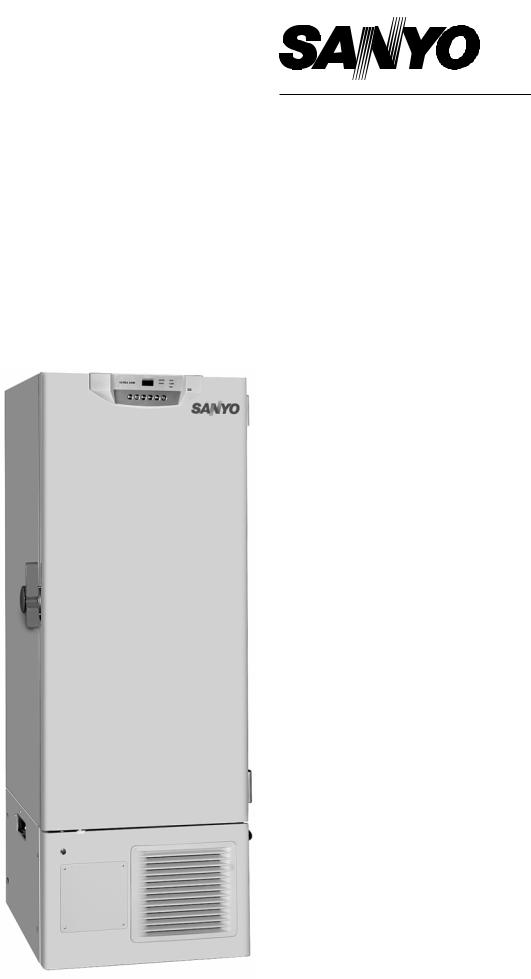
INSTRUCTION MANUAL
Ultra-Low Temperature Freezer
MDF-U32V

Note:
1.No part of this manual may be reproduced in any form without the expressed written permission of SANYO.
2.The contents of this manual are subject to change without notice.
3.Please contact SANYO if any point in this manual is unclear or if there are any inaccuracies.
SANYO Electric Biomedical Co., Ltd. All rights reserved. Printed in Japan.
CONTENTS
PRECAUTIONS FOR SAFE OPERATION |
P. 2 |
CAUTIONS FOR USAGE |
P. 6 |
ENVIRONMENTAL CONDITIONS |
P. 7 |
FREEZER COMPONENTS |
P. 8 |
Control panel and keypad |
P.10 |
INSTALLATION |
|
Installation site |
P.11 |
Installation |
P.12 |
OPTIONAL COMPONENTS |
|
Temperature recorder |
P.13 |
Back-up system |
P.14 |
Inventory rack |
P.15 |
START-UP OF UNIT |
P.16 |
TEMPERATURE SETTING |
|
Chamber temperature |
P.17 |
Key lock function |
P.17 |
Alarm temperature setting |
P.18 |
ALARMS & SAFETY FUNCTIONS |
P.19 |
SETTING OF ALARM RESUME TIME |
P.20 |
REMOTE ALARM TERMINAL |
P.21 |
MONITOR OF FREEZER STATUS |
P.22 |
CHANGE OF COMPRESSOR DELAY TIME |
P.23 |
ROUTINE MAINTENANCE |
|
Cleaning of cabinet |
P.24 |
Cleaning of condenser filter |
P.24 |
Defrosting of inside wall |
P.25 |
TROUBLESHOOTING |
P.26 |
DISPOSAL OF UNIT |
P.26 |
RECYLCE OF RECHARGEABLE BATTERY |
P.27 |
SPECIFICATIONS |
P.28 |
PERFORMANCE |
P.28 |
SAFETY CHECK SHEET |
P.29 |
1
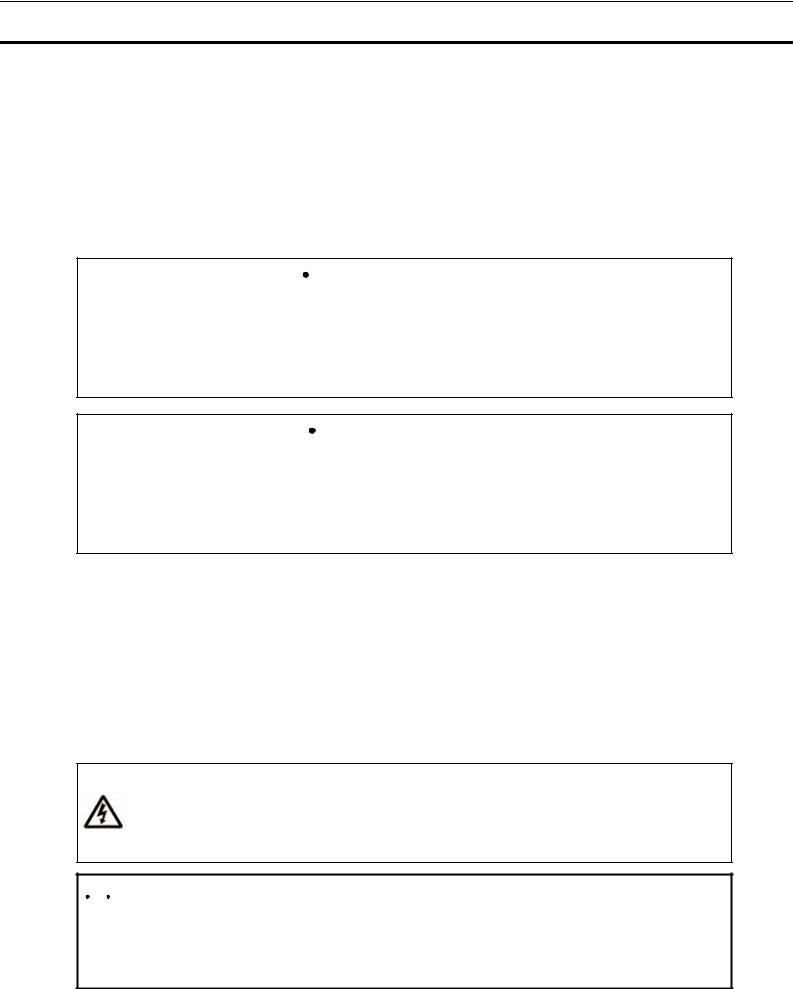
PRECAUTIONS FOR SAFE OPERATION
It is imperative that the user complies with this manual as it contains important safety advice.
Items and procedures are described so that you can use this unit correctly and safely. If the precautions advised are followed, this will prevent possible injury to the user and any other person.
Precautions are illustrated in the following way:
 WARNING
WARNING
Failure to observe WARNING signs could result in a hazard to personnel possibly resulting in serious injury or death.
 CAUTION
CAUTION
Failure to observe CAUTION signs could result in injury to personnel and damage to the unit and associated property.
Symbol shows;
 this symbol means caution.
this symbol means caution.
 this symbol means an action is prohibited.
this symbol means an action is prohibited.
 this symbol means an instruction must be followed.
this symbol means an instruction must be followed.
Be sure to keep this manual in a place accessible to users of this unit.
< Label on the unit >
This mark is labeled on the cover in which the electrical components of high voltage are enclosed to prevent the electric shock.
The cover should be removed by a qualified engineer or a service personnel only.
 WARNING
WARNING
As with any equipment that uses CO2 gas, there is a likelihood of oxygen depletion in the vicinity of the equipment. It is important that you assess the work site to ensure there is suitable and sufficient ventilation. If restricted ventilation is suspected, then other methods of ensuring a safe environment must be considered. These may include atmosphere monitoring and warning devices.
2
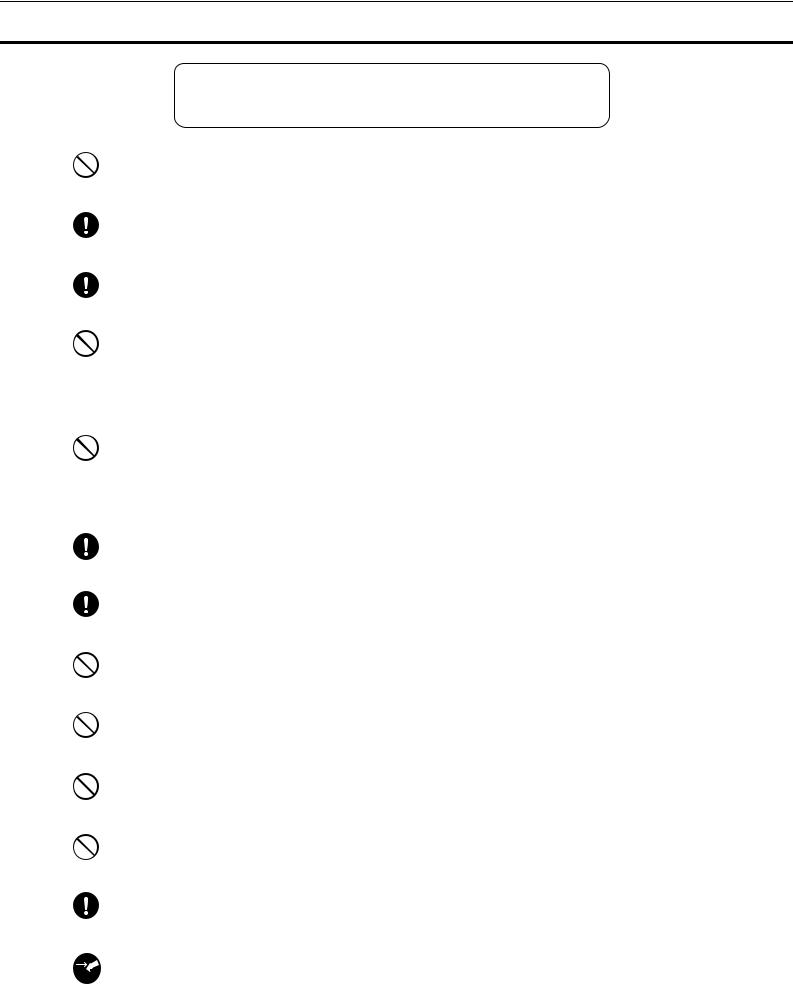
PRECAUTIONS FOR SAFE OPERATION
 WARNING
WARNING
Do not use the unit outdoors. Current leakage or electric shock may result if the unit is exposed to rain water.
Only qualified engineers or service personnel should install the unit. The installation by unqualified personnel may cause electric shock or fire.
Install the unit on a sturdy floor. If the floor is not strong enough or the installation site is not adequate, this may result in injury from the unit falling or tipping over.
Never install the unit in a humid place or a place where it is likely to be splashed by water.
Deterioration of the insulation may result which could cause current leakage or electric shock.
 Never install the unit in a flammable or volatile location. This may cause explosion or fire.
Never install the unit in a flammable or volatile location. This may cause explosion or fire.
Never install the unit where acid or corrosive gases are present as current leakage or electric shock may result due to corrosion.
 Use a dedicated power source as indicated on the rating label attached to the unit.
Use a dedicated power source as indicated on the rating label attached to the unit.
Connect the power supply plug to the power source firmly. Improper insertion may cause a heat or ignition.
Use a power supply outlet with ground (earth) to prevent electric shock. If the power supply outlet is not grounded, it will be necessary to install a ground by qualified engineers.
Never ground the unit through a gas pipe, water main, telephone line or lightning rod. Such grounding may cause electric shock in the case of an incomplete circuit.
Never store volatile or flammable substances in this unit if the container cannot be sealed. This may cause explosion or fire.
Never store corrosive substances in this unit if the container cannot be sealed. This may lead to damage to the inner components or electric parts.
Do not insert metal objects such as a pin or a wire into any vent, gap or any outlet for inner air circulation. This may cause electric shock or injury by accidental contact with moving parts.
Use this unit in safe area when treating the poison, harmful or radiate articles. Improper use may cause bad effect on your health or environment.
Disconnect the power supply to the unit prior to any repair or maintenance of the unit in order to 


 prevent electric shock or injury.
prevent electric shock or injury.
3
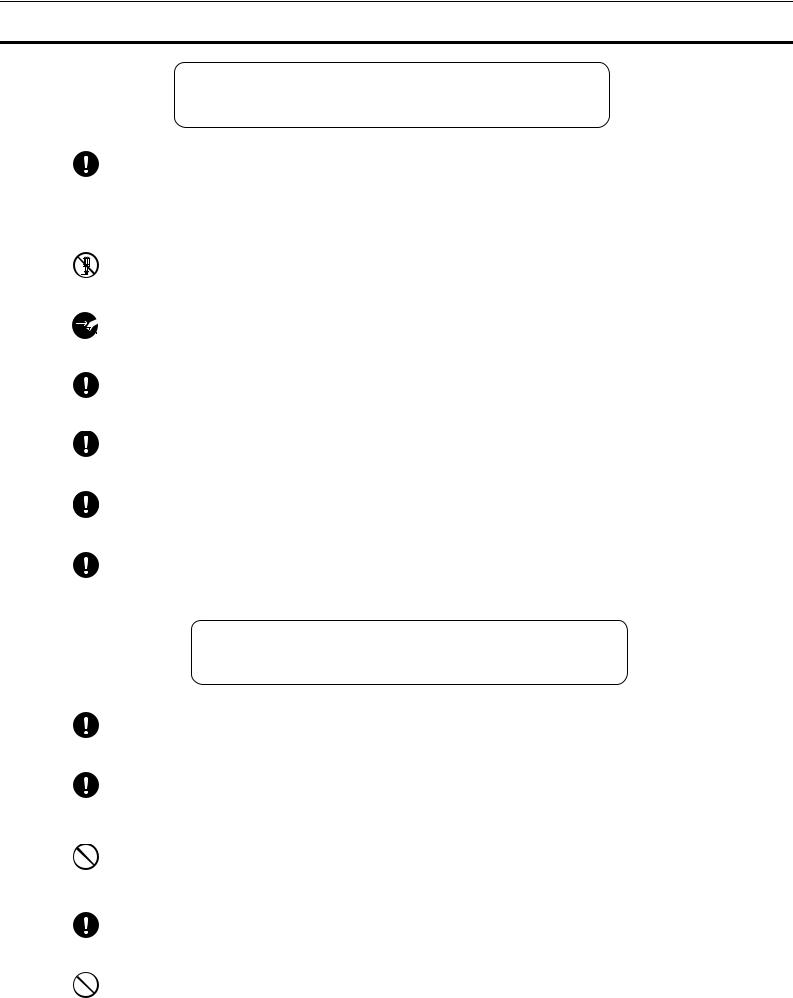
PRECAUTIONS FOR SAFE OPERATION
 WARNING
WARNING
Ensure you do not inhale or consume medication or aerosols from around the unit at the time of maintenance. These may be harmful to your health.
 Never splash water directly onto the unit as this may cause electric shock or short circuit.
Never splash water directly onto the unit as this may cause electric shock or short circuit.
Never disassemble, repair, or modify the unit yourself. Any such work carried out by an unauthorized person may result in fire or injury due to a malfunction.
Disconnect the power supply plug if there is something wrong with the unit. Continued 


 abnormal operation may cause electric shock or fire.
abnormal operation may cause electric shock or fire.
If the unit is to be stored unused in an unsupervised area for an extended period, ensure that children do not have access and that doors cannot be closed completely.
The disposal of the unit should be accomplished by appropriate personnel. Remove doors to prevent accidents such as suffocation.
Ventilate the room air when using the carbon dioxide gas for the back-up system. The CO2 density level in the air could rise and may be harmful to humans.
Prepare a safety check sheet when you request any repair or maintenance for the safety of service personnel.
 CAUTION
CAUTION
Select a level and sturdy floor for installation. This precaution will prevent the unit from tipping. Improper installation may result in water spillage or injury from the unit tipping over.
Connect the unit to a power source as indicated on the rating label attached to the unit. Use of any other voltage or frequency other than that on the rating label may cause fire or electric shock.
Never bind, process, or step on the power supply cord, or never damage or break the power supply plug. Do not use the supply plug if its cord is loose. This may cause fire or electric shock.
When removing the plug from the power supply outlet, grip the power supply plug, not the cord. Pulling the cord may result in electric shock or fire by short circuit.
Do not touch any electrical parts such as the power supply plug or any switches with a wet hand. This may cause electric shock.
4
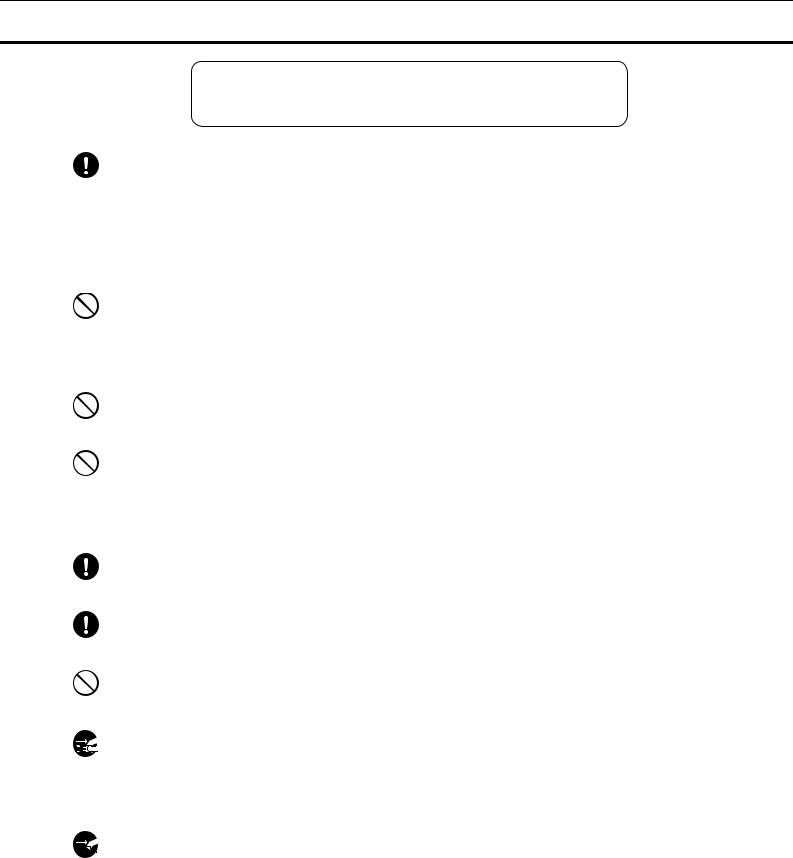
PRECAUTIONS FOR SAFE OPERATION
 CAUTION
CAUTION
Check the setting when starting up of operation after power failure or turning off of power switch. The stored items may be damaged due to the change of setting.
Do not put a container with water or heavy articles on the unit. It may cause injury if the articles  fall. Current leakage or electric shock may be resulted form the deterioration of insulation by spilled
fall. Current leakage or electric shock may be resulted form the deterioration of insulation by spilled
water.
Do not climb onto the unit or do not put articles on the unit. This may cause injury by tipping or damage to the unit.
 Always hold the handle when closing the door. This will reduce the likelihood of a trapped finger.
Always hold the handle when closing the door. This will reduce the likelihood of a trapped finger.
Do not put glass bottles or cans into the compartment since they may be broken by frozen contents and cause injury.
Do not touch the stored items with bare hand. Handing frozen contents or the inside walls with naked hand may cause frostbite.
 Do not lean on the door. This may cause injury if the unit tips over or door is broken.
Do not lean on the door. This may cause injury if the unit tips over or door is broken.
Put on gloves at the time of maintenance to prevent injury by the edge or corner of the components.
Check the filter mentioned in this manual and clean it as necessary. A dusty filter may cause temperature rise or failure.
Do not touch the condenser directly when the filter is removed for cleaning. This may cause injury by hot surface.
Disconnect the power supply plug before moving the unit. Take care not to damage the power cord. A damaged cord may cause electric shock or fire.
 Be careful not to tip over the unit during movement to prevent damage or injury.
Be careful not to tip over the unit during movement to prevent damage or injury.
Disconnect the power plug when the unit is not used for long periods. Keeping the connection may 


 cause electric shock, current leakage, or fire due to the deterioration of insulation.
cause electric shock, current leakage, or fire due to the deterioration of insulation.
 Do not put the packing plastic bag within reach of children as suffocation may result.
Do not put the packing plastic bag within reach of children as suffocation may result.
5

CAUTIONS FOR USAGE
1.When the first start-up or start-up after no use of long period, the warning device may not operate, because its Ni-MH battery has completely discharged. This does not denote a malfunction. In this case, continue to operate the unit for about 3 hours, then push the test switch to check if the warning device operates. To fully recharge the completely discharged battery, the unit has to be operated for about 2 days.
2.In the case of high ambient temperature, the cabinet front may heat up after the freezer starts to operate first. However, this does not denote a malfunction. It is due to the hot gas piped around the unit frame to prevent condensation around the cabinet.
3.Cool down the freezer chamber sufficiently before storing materials and put the materials in a small batch to reduce the temperature rise.
4.The digital thermometer of this ultra-low temperature freezer is designed to display the temperature of the center part of the freezing compartment. The thermometer sometimes displays a temperature a little bit higher than the actual temperature of the center part depending on the amount or arrangement of stored items.
5.An access port to take out the measuring cable in the case is provided on the back wall and right bottom of the freezer. Be sure to replace the cap and thermal insulation after taking out of the cable, or the chamber temperature cannot complete down, and frost may accumulate outside the port surroundings.
6.Always open and close the door gently. Rough operation may lead fall down of stocked items, incomplete closing, or damage of door gasket.
7.Check and rectify the problem as soon as possible when the alarm lamp is light and buzzer is activated. Refer to table 5 on page 19 for the alarm.
8.Do not use brushes, acids, thinners, powdered soap or hot water for cleaning the freezer. Polishing powders or hot water can deteriorate the painted surfaces or cause deformation, discoloration or degeneration of plastic or rubber components. Be especially careful not to wipe plastic or rubber parts with volatile solvents such as benzine. Wipe off a diluted neutral dishwashing detergent completely with a wet cloth when it is used.
9.The frost will be built up on the chamber wall and inner door during operation. Use a scraper provided with the freezer or equivalent tool to remove the frost. The inner door is hard to be opened when a large amount of frost is built up on it. In this case, remove the frost by detaching the inner door as shown in page 25.
10.There are pipelines for cooling behind the walls. Do not defrost inside walls using a knife, ice pick, or screw driver. Be careful not to damage the walls or to make a hole on the walls as this could cause a failure of the freezer. Also, take care not to drop a heavy item or anything with sharp edge on the bottom of the chamber.
11.Because of a large freezer, the following facilities are needed; a dedicated power outlet of more than 15A capacity, a motor breaker of more than 15A or a general-purpose breaker of more than 30A. Do not use a branched socket for power source as it may cause unstable voltage and result in a failure of the unit. Always use a dedicated power outlet. For details, consult a Sanyo sales representative or an electrician.
6

ENVIRONMENTAL CONDITIONS
This equipment is designed to be safe at least under the following conditions (based on the IEC-1010-1):
1.Indoor use;
2.Altitude up to 2000 m;
3.Ambient temperature 5oC to 40oC
4.Maximum relative humidity 80% for temperature up to 31oC decreasing linearly to 50% relative humidity at 40oC;
5.Mains supply voltage fluctuations not to exceed ±10% of the nominal voltage;
6.Other supply voltage fluctuations as stated by the manufacturer;
7.Transient overvoltages according to Installation Categories (Overvoltage Categories) II; For mains supply the minimum and normal category is II;
8.Pollution degree 2 in accordance with IEC 664.
7
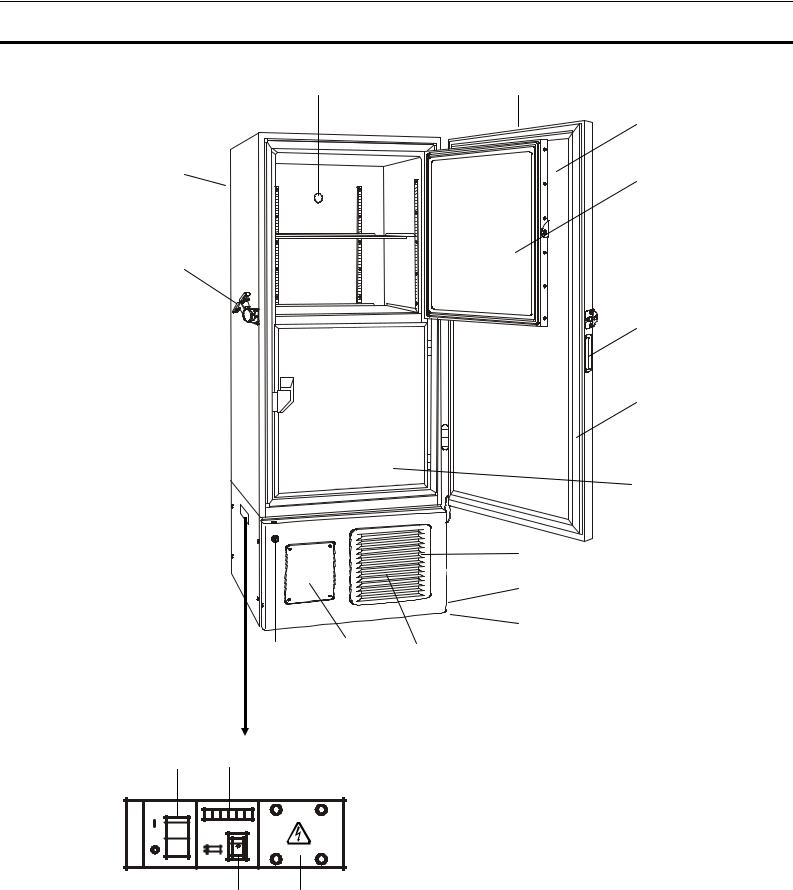
FREEZER COMPONENTS
5 |
8 |
11
3
12
10
9
7 |
14 |
15 inside |
13 17
16 18
8
1
6
2
4
5 inside
